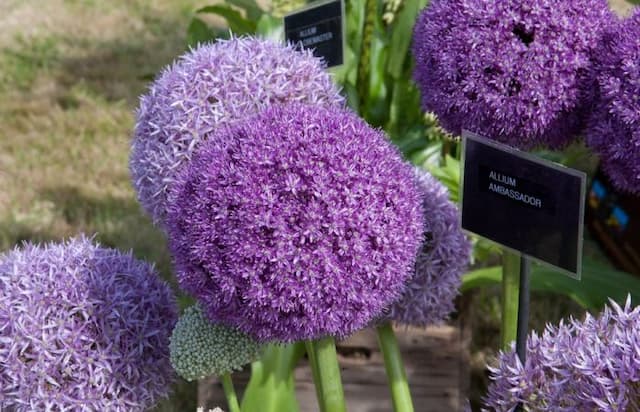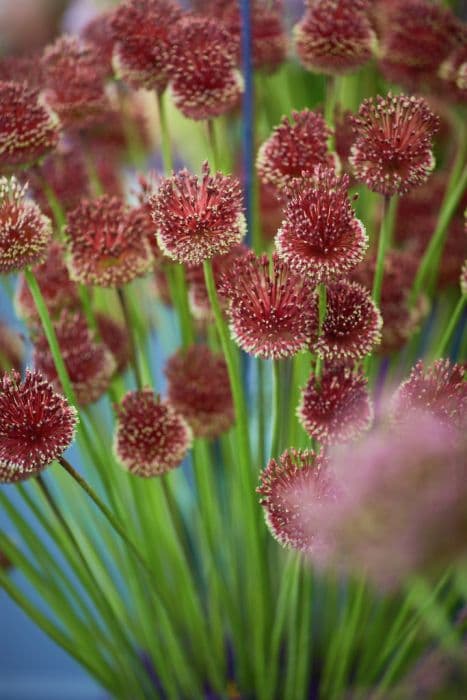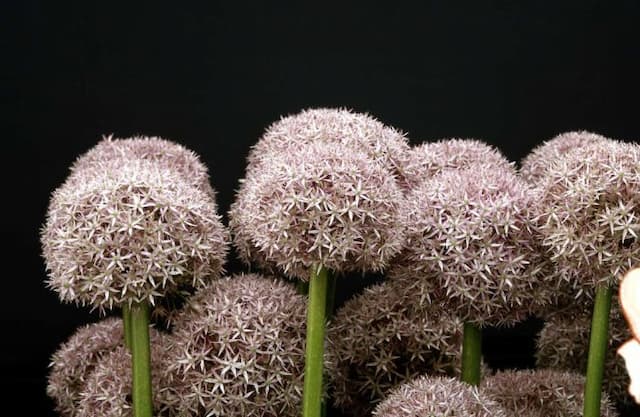Hooker chive Allium hookeri

ABOUT
Allium hookeri, commonly known as Hooker's onion, is a perennial plant with a rosette of leaves at the base. The leaves are typically fleshy, broad, and have a waxy texture, with a vibrant green color that can add an ornamental quality to the plant. The plant's flowers are clustered on the umbels, and they are usually star-shaped, blooming in an attractive array of white or cream colors, sometimes with a greenish or pinkish tinge. These flowers make it quite popular among pollinators like bees. Hooker's onion also has underground bulbs, which are usually elongated, and these can be covered with a thin, papery layer. The overall appearance of the plant makes it a suitable choice for both culinary uses and ornamental purposes in gardens and landscaping projects.
About this plant
 Names
NamesFamily
Amaryllidaceae.
Synonyms
Hooker Chive, Hooker's Onion, Himalayan Chive, Nepali Onion, Myong.
Common names
Allium hookeri var. muliense, Allium zeylanicum, Allium hookeri var. zeylanicum.
 Toxicity
ToxicityTo humans
Hooker chive (Allium hookeri) is generally considered non-toxic to humans and is actually used in various cuisines, especially in parts of South and Southeast Asia. There is no evidence that Hooker chive poses any significant toxicity risk to humans when ingested in typical food amounts. However, as with any plant, individual allergies may exist, and consumption of large quantities could potentially cause gastrointestinal discomfort or other issues due to the presence of various organic compounds.
To pets
Hooker chive (Allium hookeri) is part of the Allium family, which is known to be toxic to pets, particularly cats and dogs. Though specific studies on Hooker chive's toxicity to pets may be limited, its relation to other alliums like onions and garlic suggests that it could potentially cause similar toxic effects. If ingested by pets, symptoms could include gastrointestinal irritation, lethargy, abdominal pain, vomiting, diarrhea, elevated heart and respiratory rates, weakness, and even damage to red blood cells leading to anemia. If you suspect your pet has ingested Hooker chive, consult a veterinarian immediately.
 Characteristics
CharacteristicsLife cycle
Perennials
Foliage type
Deciduous
Color of leaves
Green
Flower color
White
Height
1-2 feet (30-60 cm)
Spread
1-2 feet (30-60 cm)
Plant type
Herb
Hardiness zones
7
Native area
Himalayas
Benefits
 General Benefits
General Benefits- Culinary Flavor: Allium hookeri, commonly known as Hooker's onion, is used to enhance the taste of various dishes with its distinct flavor.
- Nutrient Rich: The plant is known to be a good source of vitamins, minerals, and essential amino acids, contributing to a balanced diet.
- Edible Parts: Both the leaves and roots of Hooker's onion can be consumed, offering versatility in kitchen use.
- Gardening: This plant can be easily grown in home gardens, which adds ornamental value and can be used in companion planting to help deter pests.
- Soil Improvement: Hooker's onion can contribute to soil health by providing nutrients and improving soil structure.
 Medical Properties
Medical Properties- Antioxidant: Contains compounds that may help to reduce oxidative stress and prevent cell damage.
- Anti-inflammatory: May help in reducing inflammation in the body.
- Antimicrobial: Exhibits properties that can inhibit the growth of certain bacteria and fungi.
- Immunomodulatory: Might influence immune system functions, potentially enhancing immune response.
- Antidiabetic: There are indications it may help in managing blood sugar levels.
 Air-purifying Qualities
Air-purifying QualitiesThis plant is not specifically known for air purifying qualities.
 Other Uses
Other Uses- Traditional dye: The roots of Allium hookeri can be used to create a yellow dye for textiles, offering a natural alternative to synthetic dyes.
- Insect repellent: The strong scent of the leaves can act as a natural deterrent against insects in gardens and homes.
- Companion planting: When planted in vegetable gardens, Allium hookeri can help to repel pests away from more sensitive crops due to its strong odor.
- Culinary wrapping: The large leaves are sometimes used to wrap fish or meat during grilling or steaming, infusing the food with a subtle onion-like flavor.
- Fodder for livestock: In some regions, the plant is cultivated as fodder for cattle, goats, and sheep due to its nutritional properties.
- Soil improvement: The plant can be used in crop rotation to enhance soil fertility and structure due to its deep rooting system.
- Preservation: Leaves and bulbs can be fermented or pickled to preserve them for extended periods, providing a continuous source of the plant's flavors and nutrients.
- Botanical illustration: Allium hookeri's distinct appearance makes it a frequent subject for botanical artists and illustrators.
- Organic mulch: Decomposing leaves can be used as organic mulch, providing soil nutrition and helping with water retention.
- Floral arrangements: The long stems and cluster of small, star-shaped flowers can be included in floral arrangements for their aesthetic and aromatic qualities.
Interesting Facts
 Feng Shui
Feng ShuiThe Allium hookeri is not used in Feng Shui practice.
 Zodiac Sign Compitability
Zodiac Sign CompitabilityThe Allium hookeri is not used in astrology practice.
 Plant Symbolism
Plant Symbolism- Resilience - Allium hookeri, commonly known as Hooker's onion, often symbolizes resilience due to its ability to thrive in different and sometimes challenging environments.
- Longevity - Similar to other members of the allium family, Hooker's onion represents longevity, attributed to its hardy nature and long-lasting blooms.
- Unity - The spherical shape of the flower's inflorescence, composed of many small florets, can represent unity and togetherness, much like individuals creating a strong community.
- Protection - In some cultures, alliums are believed to ward off evil spirits, and they're planted to offer protection due to their strong scent which is perceived to purify the air.
- Prosperity - The plant's robust growth can be symbolic of prosperity and abundance, often related to the plant's prolific nature and abundant seed production.
 Water
WaterThe Hooker's onion should be watered when the top inch of soil feels dry, generally every one to two weeks depending on the weather and indoor conditions. Use a watering can or hose to water at the base of the plant, avoiding the leaves, to minimize the risk of fungal diseases. Provide approximately 1 gallon of water per square yard of soil each time you water, ensuring the moisture penetrates deeply to encourage root growth. During the growing season, ensure consistent watering to maintain moist soil but take care not to overwater, as Hooker's onion does not like to sit in soggy soil. Reduce watering frequency in the dormant winter months.
 Light
LightFor the Hooker's onion, it is ideal to place the plant in a spot that receives full sunlight to partial shade. It thrives best with at least six hours of direct sunlight daily, but can also manage in slightly less intense light conditions. Avoid overly shaded areas, as too little light can impede growth and reduce the plant's vitality.
 Temperature
TemperatureHooker's onion does best in temperate climates, with an ideal temperature range between 55°F and 80°F. It can tolerate a minimum temperature down to about 28°F for short periods, and a maximum temperature of approximately 90°F. Sudden temperature fluctuations should be avoided to prevent stress to the plant.
 Pruning
PruningPrune Hooker's onion by removing dead or yellowing leaves to maintain its appearance and health. This typically should be done in the spring or as needed throughout the growing season. Pruning promotes better air circulation and can stimulate new growth. The best time to perform a more thorough pruning is after the plant has flowered and the flowers begin to fade.
 Cleaning
CleaningAs needed
 Soil
SoilFor Hooker's onion (Allium hookeri), a well-draining soil mix with compost or well-rotted manure is ideal. The soil pH should be slightly acidic to neutral, ranging between 6.0 and 7.0. It’s beneficial to incorporate perlite or sand to improve drainage.
 Repotting
RepottingHooker's onion should be repotted every 2-3 years to refresh the soil and accommodate growth. Repot in spring before the growing season begins.
 Humidity & Misting
Humidity & MistingHooker's onion does well in average room humidity levels. It doesn't require high humidity but should not be placed in overly dry conditions.
 Suitable locations
Suitable locationsIndoor
Place in a sunny spot and water when the topsoil feels dry.
Outdoor
Grow in full sun to partial shade and water regularly.
Hardiness zone
7-9 USDA
 Life cycle
Life cycleAllium hookeri, commonly known as Hooker's onion, begins its life cycle with seed germination, which occurs in moist, well-drained soil under conditions of adequate warmth and sunlight. The seedlings emerge and develop into young plants, establishing a bulb as an underground storage organ. As the plant matures, leaves grow from the bulb, forming clumps of long, slender foliage that are characteristic of the allium family. Subsequently, the plant produces flowering stalks that bear clusters of star-shaped flowers, typically during the summer months, which after pollination, develop into seed capsules containing numerous seeds. Once the seeds are dispersed, the plant completes its annual growth cycle, though the bulb can remain dormant underground and sprout again the following season. Over time, Allium hookeri can also spread vegetatively through division of its bulb, leading to the formation of new clonal plants adjacent to the parent.
 Propogation
PropogationPropogation time
Spring to summer
Allium hookeri, commonly known as hooker chive, can be effectively propagated by dividing its clumps. The appropriate time for dividing hooker chive plants is during the spring or early fall. To propagate, carefully dig up the entire clump and gently separate the bulbs, ensuring that each division has a segment of the root attached. These divisions can then be immediately replanted in well-draining soil, spacing them about 4 to 6 inches (10 to 15 cm) apart. Water the new plantings thoroughly to establish them, keeping the soil consistently moist but not waterlogged during their initial growth period.









